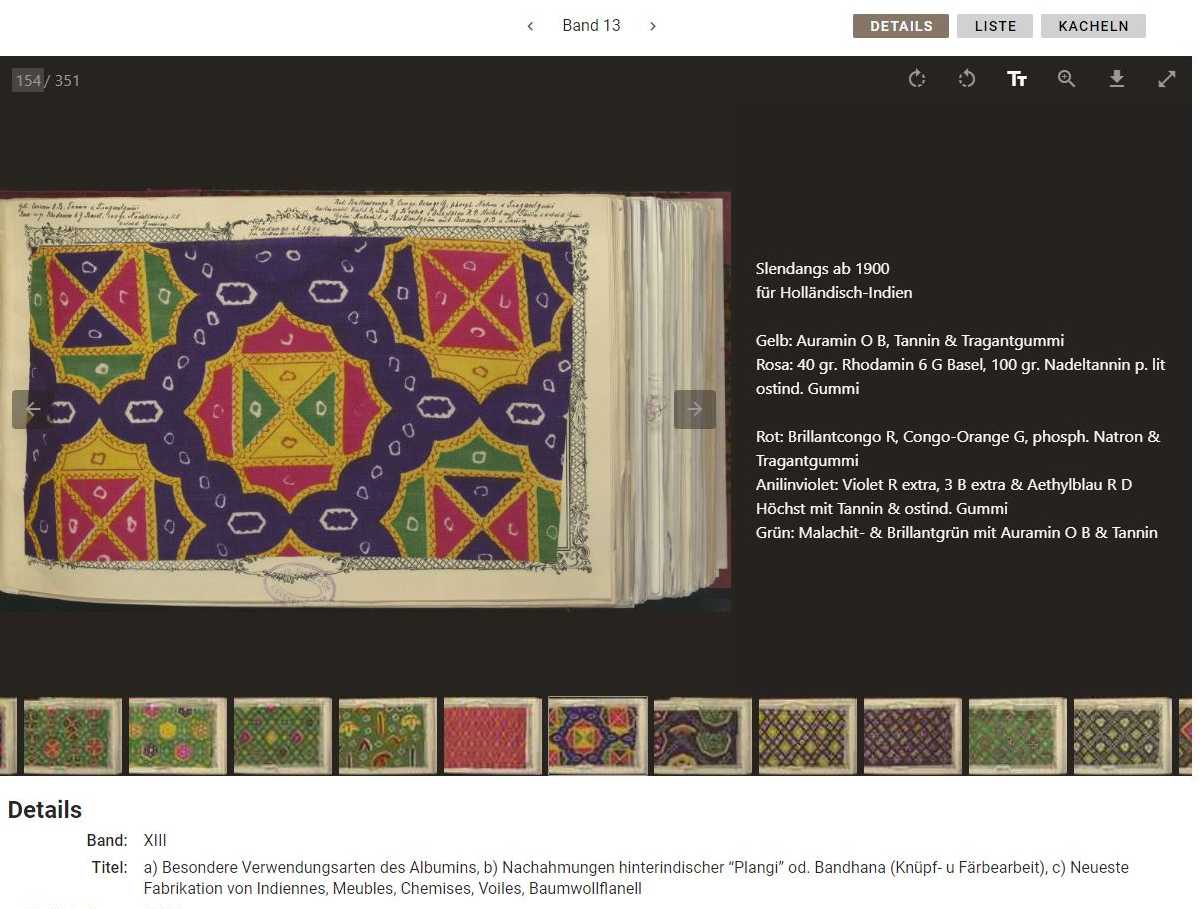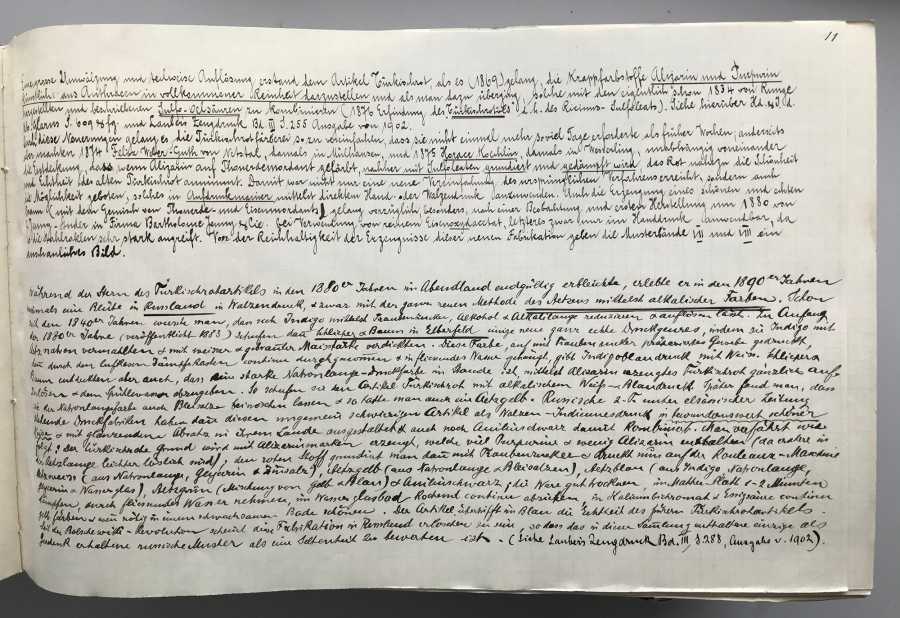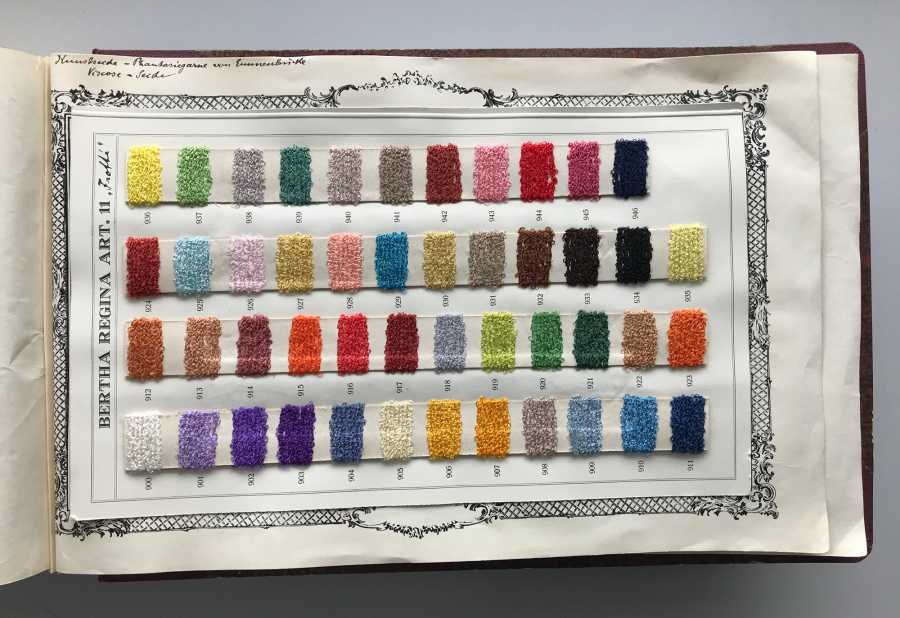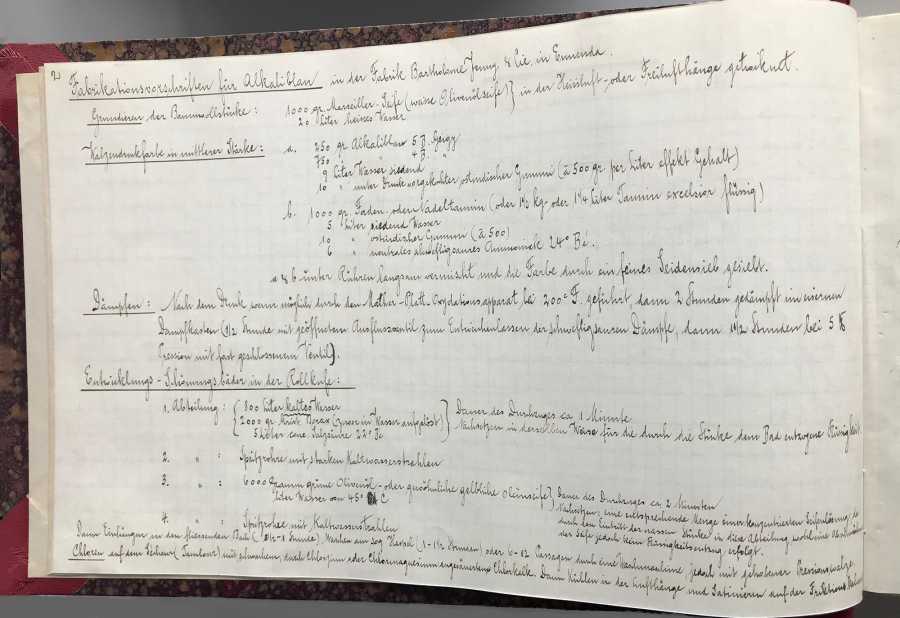
Colorful chemistry: discovering Jenny-Trümpy's fabric pattern books online
The chemical and pharmacognostic collection D-CHAB contains 17 fabric pattern books by the Swiss textile manufacturer and chemist Adolf Jenny-Trümpy. In addition to pages of colorful historical patterns (18th-20th century), many with a recipe for chemical textile dyeing, the volumes also offer an insight into the history of color chemistry and textile printing. Now freely accessible as an online catalog, the digitized volumes invite everyone to discover the colorful sides of chemistry.
Have you ever considered the specific colors of your clothing, how the patterns are created on the fabric, and the role of chemistry in this process? As a non-expert, you might simply notice that the scarf you are wearing today remains colorful even after many washes and features a lovely ornate plant pattern. But this is not even half of the story.

Textile manufacturer and chemist Adolf Jenny-Trümpy reveals in his colorful, annotated fabric pattern books how textile printing worked in the past. Between 1907 and 1934, Jenny-Trümpy compiled nine sets, each of 22 volumes containing the most important fabric samples from the Glarus region and the company Bartholome Jenny & Cie. He left 17 volumes from this series to the "Chemie-Schule des eidgenössischen Polytechnikums," where research on dyes such as indigo was carried out for many years. The other five books of this series are in the Affoltern Collection Center.
If you browse through the books, you will come across a colorful treasure trove of graphic samples printed on various types of textiles. The volumes also include precise information on the chemistry and synthesis of the dyes used, the dyeing conditions, and the history of color chemistry, which was not only based on organic chemistry but also used metal dye complexes.
It quickly becomes clear that for the expert from Ennenda in Switzerland, the scarf mentioned at the beginning would not simply have been colorful but perhaps dyed with steam pink, benzopurpurine, malachite green, azo black, or aniline violet, lightfast, and soapfast, and decorated with palmettos (complex fan palm patterns). In short: Jenny-Trümpy may have assessed it as an artwork of the highest level of craftsmanship and chemical know-how.

Chemical know-how from cochineal dyes to cow dung
To understand this, one has to keep in mind that in the 19th century, patterns such as palmettos, still a trend today, had to be laboriously transformed from a paper design into a kind of stamp (model). This model was then dipped in specially produced dyes and printed onto fabrics. Depending on the material, the fabric workers used tailored processes and complex dyeing recipes.
Jenny-Trümpy's books outline, for example, that natural dyes from plants and animals were used in Ennenda for quite a long time – including dwarf buckthorn berries (yellow tones), indigo (blue tones) and cochineal (red tones) – until artificially synthesized tar dyes conquered the textile industry and opened up new possibilities for colors, patterns and accessibility.
Skimming through the notes one will learn about bizarre methods as well: before dyeing, the textiles were often “cow dunged”, so immersed in a broth of cow dung, lukewarm water, water glass*, and chalk to make them easier to dye. The phosphates in the cow dung probably helped to precipitate aluminum and iron salts, contributing to the formation of lake pigments (“Farblacke”). * glassy sodium, potassium and lithium silicates or their aqueous solution
















Another important step in the dyeing process was mordanting – the chemical fixation of dye on fabric using substances such as chromium acetate, alum, or iron acetate – and the so-called “Schönen” (a color-enhancing after-treatment of the dye). A mercury sublimate bath, for example, was used for the color-enhancing and fixing of purple acid, also known as guano red, because the uric acid required for its production was often obtained from South American bird dung as Jenny-Trümpy points out in one chapter.
In the end, Jenny-Trümpy's books are also a testimony to the technological developments that extended the printing processes to fabrics other than cotton and enabled mass production. At the same time, the volumes document the 20th-century decline of traditional Glarus textile printing, an industry that had dominated the international market for decades with exports to Europe, Asia, Africa, and South America.
In 1906, it was foreseeable that Jenny-Trümpy's company in Ennenda would close as well, possibly giving rise to the idea of collecting the accumulated know-how in print sample books for posterity and making the knowledge accessible.
Fabric sample books as an online catalog
To preserve the fragile books, some of which are over a hundred years old, and ensure that they can continue to serve their purpose in the future, Public Relations D-CHAB initiated a digitization project funded by ETH Zurich Collections and Archives. Between 2023 and 2024, the 17 volumes in the D-CHAB collection have been fully digitized, transcribed, and transferred to a freely accessible online catalog.

The catalog designed and programmed by Maria Pechlaner makes it possible to both preserve and rediscover Adolf Jenny-Trümpy's collection, whether by using various filters for search, zooming in on the photographs, or reading the transcribed manuscript.
The latter makes it easier to understand the information and provides a good basis for future scientific projects or the planned analysis of the content – from an artistic, a textile, and, above all, a chemical perspective. The information and samples could serve as a reference, for example, for comparison with today's processes.
We hope you will be inspired and enjoy exploring the collection. Who knows? You might even discover one or two historical patterns in your own closet.
Check out Trümpy's fabric pattern books virtually
As part of a digitization project, the 17 books were completely digitized between 2023 and 2024, transcription of the handwriting included (German language), and transferred to an online catalog created specifically for this purpose. Click here to get to the online catalog. Enjoy the colorful journey into chemistry!
Further information
Adolf Jenny Trümpy's fabric pattern books
Wanner JEan-Richard A. (2016): Adolf Jenny-Trümpy und seine Sammlungen von Stoffmustern. URL: external page http://www.annatextiles.ch/druck_ennenda/text/musterband.htm



